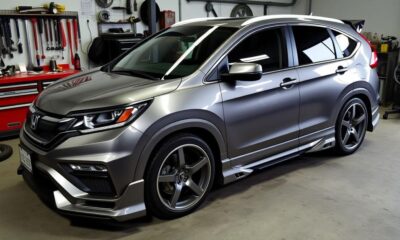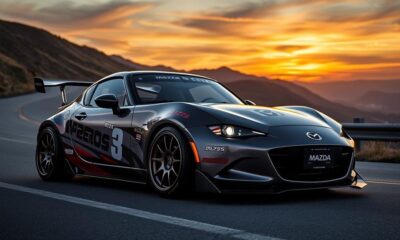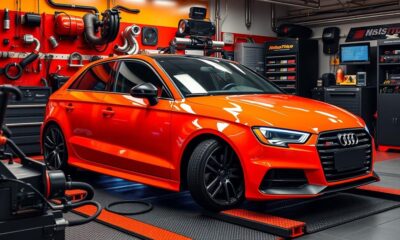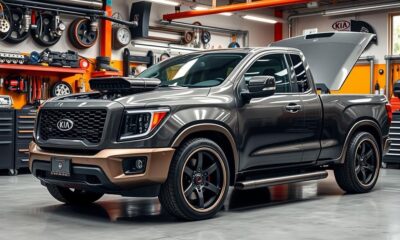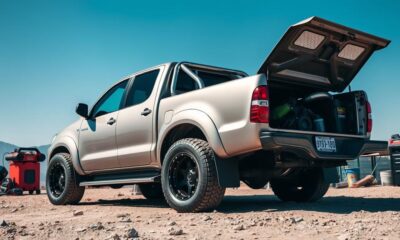Tesla Tuning
Rivian Vs. Tesla: Is Rivian Really Owned by Tesla?
Mysteriously connected or fiercely independent, discover the truth about Rivian and Tesla’s ownership status that could surprise you.

Rivian isn't owned by Tesla; it operates independently with its own goals and vision. Founded in 2009, Rivian focuses on adventure-oriented electric vehicles, unlike Tesla, which has dominated the market since 2003 with a broad range of models. Rivian's major investors include Amazon and Ford, but there are no ownership ties to Tesla. Rivian aims to cater to outdoor enthusiasts, while Tesla emphasizes performance and innovation. If you're curious about their unique features and market positioning, you'll find even more insights ahead. On top of their focus on adventure-oriented electric vehicles, Rivian has also made a name for itself through its emphasis on sustainability and environmental responsibility. In contrast, controversies surrounding Tesla, such as the use of controversial production methods and CEO Elon Musk’s outspoken behavior, have affected the public perception of the company. Despite the differences, both companies are committed to advancing the electric vehicle industry and shaping the future of transportation.
Key Takeaways
- Rivian operates independently and is not owned by Tesla, maintaining its own leadership under founder RJ Scaringe.
- There are no ownership ties between Rivian and Tesla, confirming their status as separate companies.
- Major shareholders of Rivian include Amazon (20%) and Ford (13%), further illustrating its independence from Tesla.
- Rivian was founded in 2009, while Tesla was established in 2003, making them distinct entities in the EV market.
- Rivian focuses on adventure-oriented electric vehicles, contrasting Tesla's emphasis on performance and innovation.
Overview of Rivian and Tesla

When comparing Rivian and Tesla, you'll notice that both companies are shaping the electric vehicle landscape in unique ways.
Rivian, founded in 2009, has emerged as an independent manufacturer focused on adventure-oriented electric vehicles, like the R1T pickup and the R1S SUV. The R1S, introduced in 2022, boasts rugged styling and impressive outdoor capabilities, including a towing capacity of 7,700 pounds.
On the other hand, Tesla, established in 2003, has become a leader in the EV market with its well-known models, including the Model X, which debuted in 2016. The Model X features rapid acceleration, unique falcon-wing doors, and performance trims that can reach up to 1,020 horsepower, achieving 0-60 mph in just 2.5 seconds.
While both companies target the electric vehicle market, they cater to different audiences. Rivian's focus on adventure contrasts sharply with Tesla's emphasis on performance and innovation.
Ownership Structures Explained

When you look at Rivian's ownership structure, you'll see it operates independently, with RJ Scaringe at the helm and no ties to Tesla.
Major shareholders like Amazon and Ford bring significant investments, shaping Rivian's competitive stance in the market.
Understanding these dynamics is essential as you compare Rivian's approach to Tesla's established ownership and operational model.
Rivian's Independent Ownership Status
Rivian stands out in the electric vehicle market due to its independent ownership structure. Unlike some might think, Rivian isn't owned by Tesla; it operates independently under the leadership of founder RJ Scaringe.
The company initially launched as Mainstream Motors in 2009 but later rebranded to focus on electric adventure-oriented vehicles.
Rivian has attracted significant investments from major players, with Amazon holding about 20% and Ford possessing a 13% stake valued at around $9 billion post-IPO. This financial backing showcases Rivian's appeal, but it doesn't mean Tesla has any ownership stake.
Rivian went public on November 10, 2021, with an impressive opening stock price of $106.75, briefly elevating its market valuation above traditional automakers like GM and Ford.
Though Rivian collaborates with Ford for component supply and engineering, this partnership reflects a cooperative relationship rather than ownership or control.
Shareholder Investments Overview
Investing in Rivian offers a glimpse into its unique ownership structure, shaped by a mix of significant stakeholders. Founded by RJ Scaringe, Rivian has carved out a distinct identity, separate from Tesla.
Amazon stands out as a major player, holding about 20% of Rivian's shares, while Ford owns 13%, valued at roughly $9 billion post-IPO. This collaboration extends beyond investment, as Ford partners with Rivian on component supply, indicating a strategic alignment in the electric vehicle industry.
Beyond these giants, other notable investors include Cox Enterprises, T. Rowe Price, Fidelity Management, and Blackstone. This diverse array of shareholder investments reflects a strong backing for Rivian's growth trajectory, which gained momentum after its initial public offering (IPO) in November 2021, valuing the company at nearly $100 billion—outpacing traditional automakers like GM and Ford.
Such a robust investment landscape highlights Rivian's potential in the competitive electric vehicle market. Understanding these ownership dynamics is essential as you navigate the evolving landscape of automotive innovation, distinguishing Rivian's path from that of established players like Tesla.
Competitive Market Dynamics
The competitive landscape in the electric vehicle market is shaped considerably by the ownership structures of key players. Rivian stands out as an independently owned company, founded by RJ Scaringe, while Tesla is a public entity that Elon Musk and others established in 2003. This ownership dynamic influences their strategies and market positions.
Key aspects of the competitive landscape include:
- Rivian's focus on electric adventure-oriented trucks and SUVs.
- Tesla's diverse range, which includes sedans and high-performance models.
- Amazon's significant 20% stake in Rivian, enhancing its market reach.
- Ford's 13% stake in Rivian, alongside its independent EV development.
- Tesla's peak market value nearing $1 trillion, contrasting with Rivian's $13 billion market cap.
These ownership structures create distinct trajectories for both companies. Rivian aims to carve out a niche in the electric SUV segment, while Tesla continues to dominate a broader EV market.
Understanding these dynamics helps you appreciate how each company positions itself amid evolving consumer preferences and competition. As the market matures, these ownership structures will likely play a vital role in shaping future innovations and partnerships.
Market Positioning Comparison
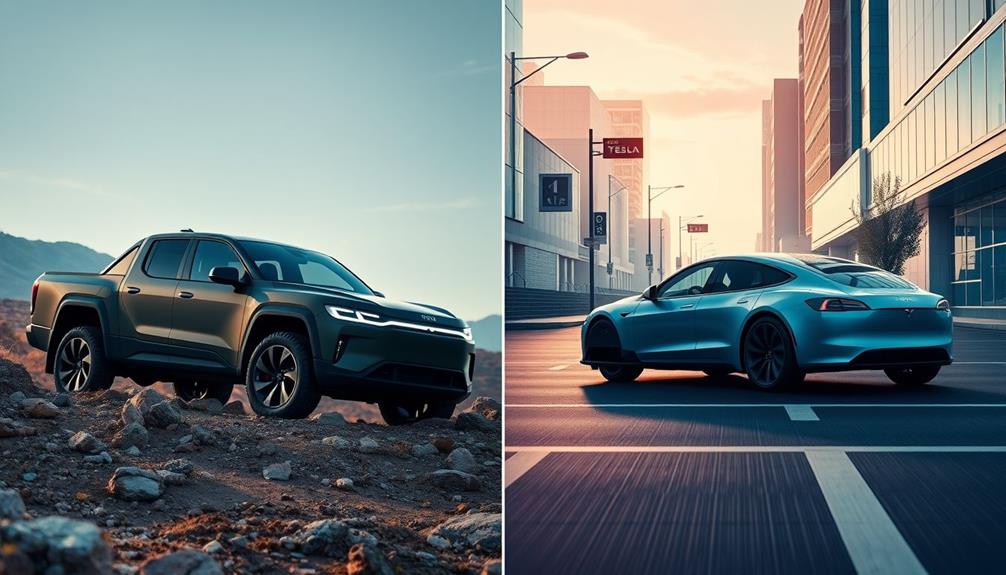
In the competitive landscape of electric SUVs, both Rivian and Tesla carve out distinct market positions. Rivian's R1S, introduced in 2022, competes directly with Tesla's Model X, launched in 2016. This rivalry centers on family-oriented electric vehicles, appealing to adventure seekers and tech enthusiasts alike.
| Feature | Rivian R1S | Tesla Model X |
|---|---|---|
| Starting Price | $74,900 | $79,990 |
| Towing Capacity | 7,700 lbs | 5,000 lbs |
| Design Focus | Rugged styling & utility | Sleek design & tech |
| Acceleration | Adventure-ready performance | Rapid acceleration |
Rivian aims to attract customers through its competitive pricing strategy, making it an attractive option amidst Tesla's established dominance. While Rivian emphasizes utility, with features like a higher towing capacity, Tesla showcases its unique elements, such as falcon wing doors and superior acceleration. Both companies have garnered significant investments, yet Rivian stands independently, providing you with an alternative to Tesla's long-standing market presence. Choosing between these electric vehicles ultimately comes down to your priorities—adventure and utility versus innovation and speed.
Vehicle Features and Specifications

When comparing the Rivian R1S and Tesla Model X, you'll find notable differences in their features and specifications that cater to diverse needs.
The Rivian R1S offers three rows of seating for up to seven passengers, while the Tesla Model X typically seats five. If cargo space is a priority, the R1S provides a generous 105 cubic feet with the seats down, compared to the Model X's 85 cubic feet.
Here are some key features to evaluate:
- Towing capacity: R1S at 7,700 pounds vs. Model X at 5,000 pounds
- Base horsepower: R1S with 533 hp vs. Model X's 670 hp
- Unique amenities: R1S includes a removable Bluetooth speaker and multiple 120-volt outlets
- Warranty: R1S offers 5 years/60,000 miles, while Model X has 4 years/50,000 miles
- Advanced technology: Both feature large touch screens and high-tech interiors
If you're contemplating the Model Y, it's worth noting that it emphasizes efficiency and range, but may not match the R1S in cargo capacity or towing capabilities.
Ultimately, your choice will depend on your specific needs and preferences.
Pricing and Value Assessment

Pricing for the Rivian R1S is quite competitive, starting at $74,900 for the Dual-Motor trim, which undercuts the Tesla Model X's base price of $79,990. This pricing strategy positions Rivian as an appealing option for buyers looking for value.
If you're interested in performance, Rivian offers upgrades like the Performance Dual-Motor model for an additional $5,000 and the Quad-Motor variant for $8,000, while Tesla's Model X Plaid trim comes in at a hefty $94,990.
Both vehicles qualify for various federal and local tax credits, impacting their overall pricing and value for you as a buyer.
Additionally, the Rivian R1S boasts a notable towing capacity of 7,700 pounds, greatly surpassing the Tesla Model X's maximum of 5,000 pounds. This added practicality makes it particularly attractive for families and adventure-seekers.
Rivian emphasizes affordability, spaciousness, and a longer range compared to earlier Tesla models, which could enhance its overall value proposition for buyers.
Reliability and Warranty Insights
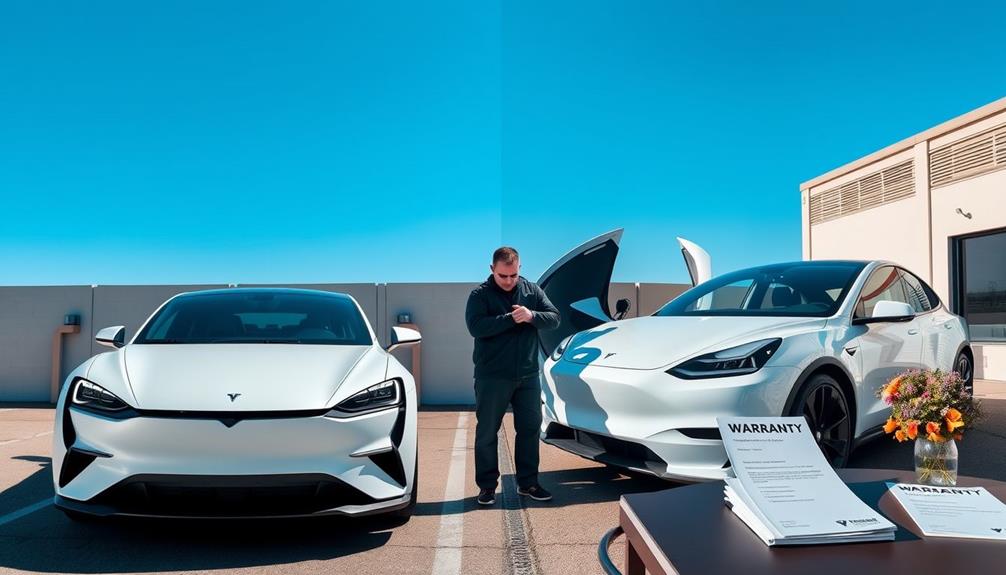
Evaluating reliability and warranty options can greatly influence your decision between the Rivian R1S and Tesla Model X. When it comes to reliability, the Tesla Model X holds a score of 72/100, classified as average by J.D. Power. In contrast, the Rivian R1S doesn't have a defined reliability score yet due to its newer market presence.
Here's a quick comparison of their warranty options:
- Tesla Model X: 4 years or 50,000 miles standard warranty
- Tesla Model X: 8 years or 150,000 miles for battery and motors
- Rivian R1S: 5 years or 60,000 miles standard warranty
- Rivian R1S: 8 years or 175,000 miles for powertrain and battery
Safety Ratings: Model X has a five-star rollover rating, while the R1S achieved top ratings in crash tests.
While the Model X showcases decent reliability and strong safety ratings, Rivian's warranty offers a bit more coverage. Your choice may hinge on how much you value reliability versus warranty assurance in your electric vehicle experience.
Driving Experience and Performance

The driving experience in the Rivian R1S and Tesla Model X showcases distinct philosophies tailored to different preferences. If you're after a smooth and refined ride, the R1S shines with its multiple drive modes, catering to various driving styles. However, it leans more towards utility, offering significant towing capability and a spacious interior, which some may find less thrilling in corners compared to Tesla's offerings.
On the other hand, the Tesla Model X delivers a powerful driving experience with its 670 horsepower base setup, providing an athletic feel through its advanced air suspension. While the R1S generates 533 horsepower, it's not as exhilarating as the sporty Tesla.
Here's a quick comparison of their driving experiences:
| Feature | Rivian R1S | Tesla Model X |
|---|---|---|
| Horsepower | 533 HP | 670 HP |
| Towing Capacity | 7,700 lbs | 5,000 lbs |
| Driving Feel | Smooth and refined | Athletic and engaging |
Ultimately, your choice will hinge on whether you prioritize utility or performance in your driving experience.
Safety Ratings and Technologies
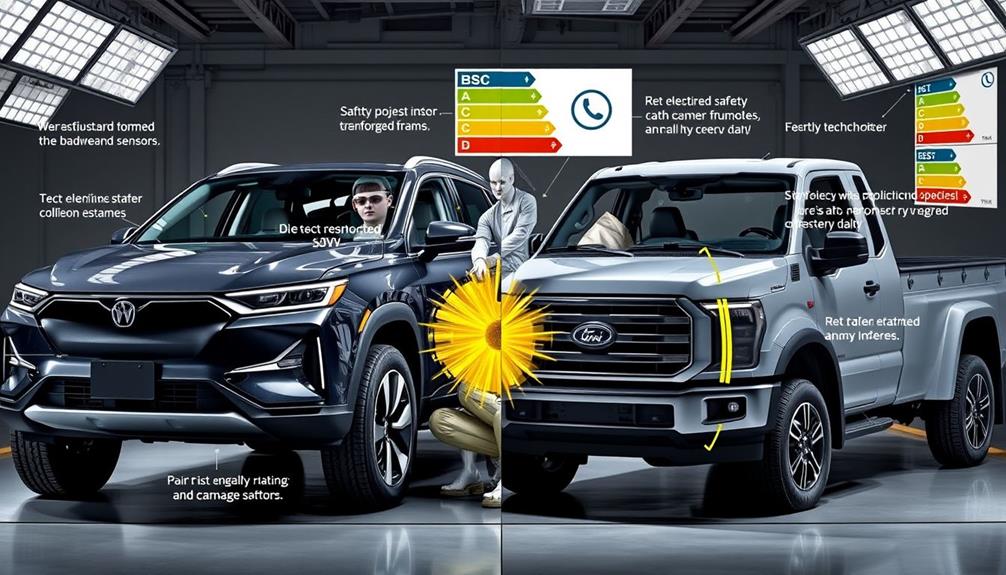
When considering the Rivian R1S and Tesla Model X, safety ratings and technologies play an important role in your decision-making process.
The Rivian R1S has impressed with top ratings in IIHS crash tests, showcasing outstanding pedestrian crash prevention capabilities. However, it did receive a Marginal score in the moderate overlap front test, indicating some areas needing improvement. The NHTSA awarded the R1S four stars in rollover tests, marking solid performance overall.
In contrast, the Tesla Model X hasn't been fully crash-tested by IIHS but boasts a five-star rollover rating from NHTSA, ensuring safety in rollover situations.
Both vehicles incorporate advanced driver-assistance technologies to enhance your safety on the road. Here are some key features:
- Emergency braking systems
- Adaptive cruise control
- Lane-keeping assistance
- Collision warning systems
- 360-degree camera views
Ultimately, while both vehicles excel in various safety ratings and technologies, it's important to weigh these factors against your specific needs and preferences. Each offers unique advantages that could influence your final choice.
Future Prospects and Innovations
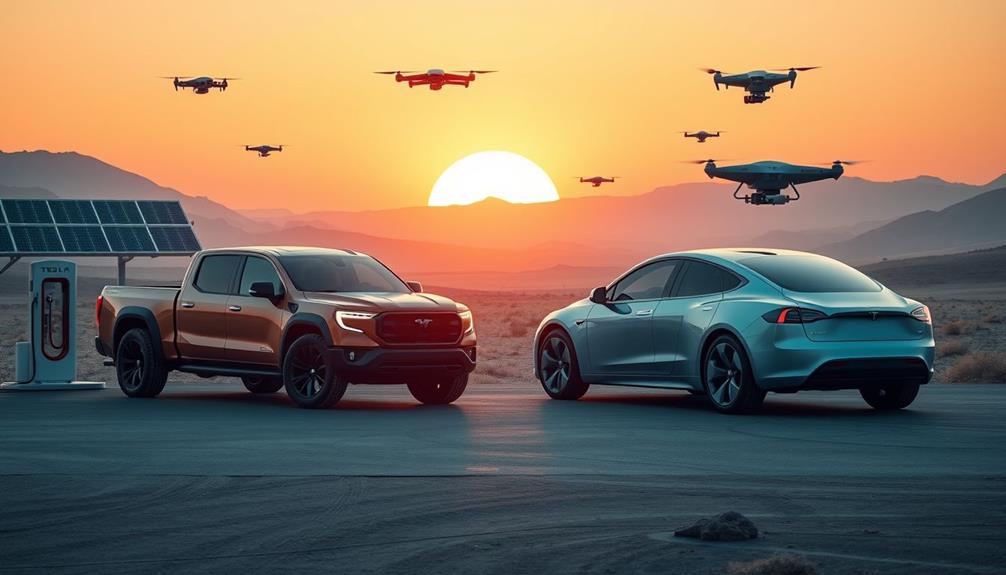
As Rivian rolls out its R2 platform, you'll see a focus on affordability that aims to shake up the competitive electric vehicle market.
The company's commitment to innovative vehicle design and in-house manufacturing could set them apart from established players.
With plans for a robust charging network and diverse product offerings, Rivian is clearly positioning itself for a dynamic future.
Rivian's R2 Platform Development
Rivian's R2 platform is set to revolutionize its approach to the electric vehicle market, making it more accessible to a broader audience. By developing this platform, Rivian aims to enhance affordability and diversify its vehicle lineup, targeting mainstream consumers.
Here's what you can expect from Rivian's R2 platform development:
- Lower-priced models to attract a wider customer base.
- Advanced battery technology for improved range and efficiency.
- Enhanced performance while reducing overall production costs.
- Sustainability goals aimed at achieving long-term profitability.
- Expansion beyond adventure-oriented models, like the R1T and R1S.
This strategic shift not only positions Rivian to increase its sales volume but also helps solidify its presence in the competitive electric vehicle landscape.
By focusing on affordability and innovation, Rivian is determined to break into the mainstream market, appealing to those who may not have considered electric vehicles before.
As Rivian continues to refine its R2 platform, it's clear that the company is committed to paving the way for a more inclusive and diverse electric vehicle experience.
Competitive Electric Vehicle Market
The electric vehicle market is rapidly evolving, with numerous players vying for dominance and innovation. Rivian's R1S electric SUV and R1T electric pickup are positioned as adventure-oriented alternatives in this competitive electric vehicle market, appealing to families and utility needs. Priced at $74,900, the Rivian R1S is more affordable than the Tesla Model X, which starts at $79,990. This strategy highlights Rivian's commitment to affordability as consumer interest in electric SUVs grows.
As Rivian plans to expand its lineup with the R2 platform, which will feature lower-priced models, it aims to enhance its market penetration. Currently, Rivian produces about 57,000 vehicles annually, while Tesla continues to dominate with its established production capabilities and brand recognition.
Rivian's strategic partnerships, including significant backing from Amazon, signal a trend of collaboration in the EV sector.
With fierce competition on the horizon, both Rivian and Tesla will need to innovate continuously to capture market share. As the landscape shifts, you can expect exciting developments that will shape the future of electric vehicles, making it essential to stay informed about these emerging players.
Innovations in Vehicle Design
In a competitive electric vehicle landscape, innovations in vehicle design play a pivotal role in attracting consumers. Rivian's approach showcases how thoughtful engineering and user-centric features can elevate the driving experience.
With the increasing demand for sustainable transportation options, the role of AI Ethicists becomes essential in ensuring that the technological advancements in vehicles are aligned with ethical standards. Their R1S and R1T models stand out with unique storage solutions tailored for adventure seekers and everyday use.
Here are some key innovations in vehicle design that Rivian offers:
- Gear Tunnel: A clever storage space that provides extra utility.
- Built-in Amenities: Includes first aid kits and tire inflators for added convenience.
- Removable Bluetooth Speakers: Enhances outdoor experiences and social gatherings.
- Advanced Air Suspension: Offers a smoother ride and improved vehicle handling.
- Sustainable Materials: Prioritizes eco-friendly options in luxurious interiors.
Rivian is also making strides with its upcoming R2 platform, aimed at delivering more affordable vehicles without compromising on quality.
This commitment to accessibility shows that Rivian isn't just innovating for the sake of it; they're redefining what electric vehicle design can be while appealing to a broader audience.
As the electric vehicle market evolves, Rivian's focus on innovations in vehicle design positions them as a strong contender against established players like Tesla.
Frequently Asked Questions
Why Did Tesla Sue Rivian?
Tesla sued Rivian over allegations that former Tesla employees took confidential information and trade secrets when they joined Rivian. This lawsuit highlighted concerns about employee poaching and the competitive landscape of the electric vehicle market.
Is Rivian Anti-Tesla?
You might think Rivian is anti-Tesla, but it's more about competition. Rivian has its own unique identity and focuses on adventure-oriented vehicles, setting itself apart from Tesla's performance-driven approach in the electric vehicle market.
Who Owns Rivian Now?
Rivian's ownership is diverse. You should know that RJ Scaringe founded it, while Amazon owns about 20% and Ford holds 13%. Other investors include Cox Enterprises and T. Rowe Price, ensuring varied support.
Is the Rivian Truck Made by Tesla?
No, the Rivian truck isn't made by Tesla. Rivian operates independently, focusing on adventure-oriented electric vehicles. They have their own production facilities and aim to compete directly in the electric vehicle market.
Conclusion
In the electric vehicle arena, Rivian stands as a distinct contender, not a mere offshoot of Tesla. While both brands champion innovation and sustainability, Rivian carves its niche with adventure-ready designs, contrasting Tesla's sleek, tech-focused approach. As you weigh your options, consider how their ownership structures and market strategies reflect their unique identities. Ultimately, whether you lean toward Rivian's rugged utility or Tesla's cutting-edge technology, both brands promise a transformative driving experience for the future.
Alex is our go-to expert on performance tuning, with over a decade of experience in the automotive industry. His deep understanding of engine dynamics, exhaust systems, and performance software allows him to break down complex concepts into easy-to-follow guides. Whether you’re looking to boost horsepower or fine-tune your vehicle’s responsiveness, Alex’s insights will help you achieve peak performance.
Tesla Tuning
How Did Tesla Die? The Mysterious End of a Genius Inventor!
Get ready to explore the mysterious circumstances surrounding Nikola Tesla’s death and uncover the secrets that vanished with him. What really happened to his legacy?

Nikola Tesla died on January 7, 1943, at the New Yorker Hotel in New York City, leaving many questions behind. Though he appeared to have died of natural causes at age 86, suspicions arose when his safe was found emptied and its contents stolen. The FBI quickly seized his belongings, fearing they could aid Axis powers during WWII. While much of Tesla's work, like the infamous Death Ray, remained theoretical, it sparked significant military interest. His eccentric lifestyle and financial struggles further added to the enigma surrounding his end, and there's much more to uncover about his mysterious legacy.
Key Takeaways
- Nikola Tesla died on January 7, 1943, at the age of 86 in the New Yorker Hotel, NYC, with circumstances surrounding his death appearing suspicious.
- His safe was found emptied, and its contents stolen, suggesting possible foul play related to his valuable inventions.
- The U.S. government seized Tesla's papers shortly after his death, fearing his inventions could be used by Axis powers during WWII.
- Investigations into his unfinished inventions, particularly the Death Ray, revealed many of his designs were speculative and unproven.
- Tesla's legacy is marked by both his groundbreaking contributions to electrical engineering and the mysterious circumstances of his death and posthumous treatment.
Circumstances of Tesla's Death

In the early hours of January 7, 1943, Nikola Tesla was discovered dead in his hotel room at the New Yorker Hotel in New York City, where he'd lived for several years. The circumstances surrounding his death have sparked numerous theories and raised eyebrows.
At 86, Tesla's passing seemed natural, but the situation quickly grew murky when authorities found his safe emptied, its contents stolen. This theft ignited suspicions of foul play, leading some to theorize that Tesla may have been murdered to prevent his revolutionary inventions from falling into the wrong hands.
The FBI's involvement further complicated matters. After Tesla's death, the U.S. Office of Alien Property seized his belongings to guarantee that his groundbreaking ideas, particularly his concept of a "death ray," wouldn't be exploited by Axis powers during World War II.
Released FBI documents in September 2016 revealed classified information, adding fuel to the fire regarding the potential military applications of Tesla's inventions. With such a mysterious end to a brilliant mind, questions linger about what truly happened in that hotel room and whether his death was merely a coincidence or something far more sinister.
The Legacy of the Death Ray

You can't ignore the weaponization of Tesla's inventions, especially the Death Ray, which sparked debates about ethics in technology.
Even today, the fascination with his ideas continues, as people ponder their implications for modern military capabilities.
This legacy raises questions about how far we should go in harnessing such powerful concepts.
Weaponization of Inventions
Many consider Nikola Tesla's "Death Ray" one of the most ambitious and controversial inventions in the history of warfare. Designed to shoot down enemy aircraft from distances of up to 250 miles, this weapon captured significant military interest during World War II. Tesla claimed it could release 100 billion watts of energy in a concentrated area, escalating public fascination. However, the Death Ray remained largely theoretical due to funding issues and implementation complexities.
Following Tesla's death in 1943, the U.S. authorities grew anxious that Nazi Germany could weaponize his inventions. Consequently, they seized his papers, fearing the implications of his legacy.
| Aspect | Details | Emotional Impact |
|---|---|---|
| Invention | Death Ray | A dream of peace turned deadly |
| Military Interest | Global attention during WWII | Tension and urgency |
| Theoretical Status | Never fully realized | Frustration and lost potential |
| Legacy | Symbol of visionary technology | A haunting reminder of what could be |
The weaponization of inventions like the Death Ray reminds us of the fine line between innovation and destruction in human history.
Cultural Fascination Persisting Today
Nikola Tesla's "Death Ray" continues to ignite interest and speculation, enchanting audiences with its blend of genius and controversy. This potent weapon, designed to shoot down aircraft from great distances, symbolizes Tesla's visionary legacy while engaging the public imagination.
The media's labeling of his invention as the "Death Ray" during World War II stoked fears of its potential use against Nazi Germany, embedding it deeply in popular culture as a mythical creation.
Despite Tesla's claims of a working prototype, investigations revealed his designs were largely speculative and unproven, leading many to question the actual feasibility of the Death Ray.
Yet, the intrigue surrounding its military applications persists, keeping his innovative ideas alive in modern discussions about defense technologies. Documentaries and series, like "Tesla's Death Ray: A Murder Declassified," explore the enigmatic aspects of his life, examining the Death Ray and contributing to a lasting cultural fascination.
As you consider Tesla's legacy, the Death Ray serves as a reminder of the fine line between brilliance and speculation, embodying both the promise and the peril of visionary ideas.
Investigation Into Tesla's Inventions

After Tesla's death, his unfinished inventions sparked a whirlwind of interest and speculation.
The U.S. Office of Alien Property seized his papers, aiming to keep his groundbreaking ideas away from enemy hands.
This action set the stage for intense investigations into the potential military applications of his work.
Unfinished Inventions After Death
Tesla's unfinished inventions, shrouded in mystery and intrigue, continue to captivate researchers and enthusiasts alike. His most notable creation, the Death Ray, was designed to target enemy aircraft from hundreds of kilometers away, yet it remained incomplete at the time of his death in January 1943.
Following his passing, the U.S. Office of Alien Property seized Tesla's belongings, including numerous patents and inventions, primarily to shield his groundbreaking work from falling into enemy hands.
Investigators like military expert Jack Murphy and historian Cameron Prince have tirelessly sought to reconstruct Tesla's Death Ray using his earlier patented designs, uncovering the depth of his visionary concepts.
However, many of Tesla's scientific records and plans mysteriously vanished, leaving the true significance of his inventions in question. His later years were marked by a lack of financial support and collaboration, leading to the abandonment of many innovative ideas, including his teleforce concept aimed at creating an invisible defense system.
Tesla's legacy, with all its unfinished inventions, raises compelling questions about what could have been achieved had he been given the resources and recognition he truly deserved.
Seizure of Tesla's Papers
The seizure of Tesla's papers by the U.S. Office of Alien Property occurred in January 1943, shortly after his death. This action aimed to prevent the Axis powers from accessing his inventions during World War II. Tesla's nephew, Sava Kosanović, tried to inspect his uncle's belongings but faced scrutiny from the FBI, who suspected espionage.
An MIT physicist later evaluated Tesla's papers and found them largely speculative and impractical, casting doubt on their military significance. This led to ongoing speculation about the potential loss of valuable technological insights. Despite the lack of concrete evidence supporting the military utility of Tesla’s work, his visionary ideas continue to inspire both scientific curiosity and technological innovation. This enduring interest has fueled discussions not only about the past but also about the future, as people frequently wonder, “is Tesla stock worth buying,” referencing not the inventor, but the modern electric vehicle company that bears his name. While the legacy of Nikola Tesla’s innovations remains a subject of debate, his brand lives on through technological advancements in other fields today.
| Event | Details |
|---|---|
| Date of Seizure | January 1943 |
| Agency Involved | U.S. Office of Alien Property |
| Family's Response | Sava Kosanović's attempt to inspect |
| FBI's Concern | Suspected espionage |
| Court Ruling | 1952 allowed release to a museum in Yugoslavia |
In 1952, a court ruling allowed Tesla's original papers to be sent to a museum in Communist Yugoslavia, inadvertently granting Soviet scientists access to his groundbreaking research. The repercussions of this seizure are still debated today.
Tesla's Life and Achievements
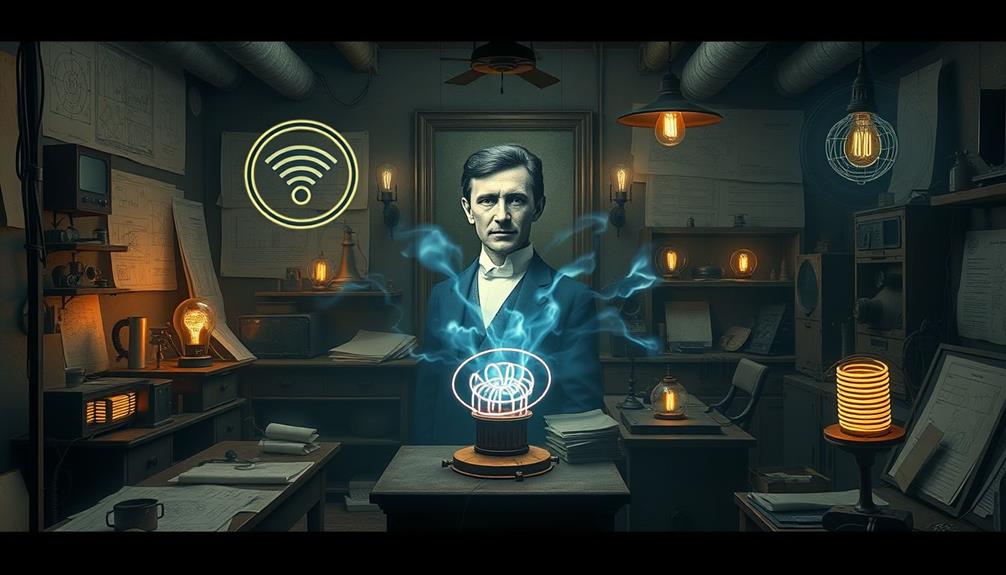
Born on July 10, 1856, in Smiljan, Croatia, Nikola Tesla transformed the world of electrical engineering with his revolutionary ideas and inventions. You might know him best for developing alternating current (AC) systems, which became the foundation for modern electrical power distribution. His invention of the AC motor changed the way electricity was utilized in machinery, allowing for more efficient operations.
During his time in Colorado Springs, Tesla made significant contributions to wireless power transmission, famously lighting 200 bulbs from a distance of 26 miles. This demonstration showcased his vision for a world powered by wireless energy.
With around 300 patents to his name, Tesla's inventions went beyond mere practicality; they represented groundbreaking ideas that pushed the limits of technology. Among his more ambitious concepts was the "death ray," an unfinished weapon capable of shooting down aircraft from hundreds of miles away.
Although Tesla faced financial struggles later in life, his legacy as a pioneer of electrical engineering and innovation remains undeniable. His work laid the groundwork for future advancements, ensuring that his brilliance wouldn't be forgotten, despite the challenges he faced.
The Impact of His Eccentricities

His remarkable achievements in electrical engineering came hand in hand with a lifestyle that many found perplexing. Tesla's eccentric lifestyle shaped his enigmatic public persona, making him a mysterious figure.
He spoke eight languages fluently and cared for pigeons in his hotel rooms, which only added to his unusual behaviors. However, his financial struggles and isolation during the 1930s led to a decline in recognition.
His obsession with inventions, from wireless energy transmission to the elusive "death ray," highlighted his visionary but sometimes delusional mindset. This fixation often meant he didn't take notes or create blueprints, relying instead on his synesthesia for creative thinking.
As a result, many of his ideas remained intangible, and his groundbreaking work faded from public consciousness.
Government Seizure of Tesla's Work

Seizing Tesla's belongings after his death in January 1943, the U.S. government aimed to prevent Axis powers from accessing his groundbreaking inventions during World War II. The urgency to safeguard Tesla's work reflected the military significance attributed to his research.
However, the aftermath of this seizure led to confusion and controversy.
- The FBI suspected Tesla's nephew, Sava Kosanović, of espionage when he sought to inspect his uncle's possessions.
- An MIT physicist assessed Tesla's papers, deeming them speculative and impractical, yet their potential military applications raised eyebrows.
- In 1952, a court ruling allowed the release of Tesla's original papers, which eventually reached a museum in Communist Yugoslavia, granting Soviet scientists access.
This posthumous seizure wasn't just about protecting national security; it also highlighted the government's apprehension regarding the implications of Tesla's inventions.
The struggle over custody of Tesla's belongings and papers underscored a broader narrative about the intersection of genius, innovation, and government control during a tumultuous era. What could have been a treasure trove of knowledge turned into a complex legal and political saga.
Frequently Asked Questions
What Caused Tesla's Death?
You might think Nikola Tesla's death stemmed from various health issues, but ultimately, it was heart failure that claimed his life. His later years were marked by solitude, which likely exacerbated his declining health.
What Happened to Tesla at the End of His Life?
What happens to a brilliant mind when isolation takes hold? At the end of his life, you'll find Tesla living alone, struggling financially, and surrounded by a whirlwind of unfinished inventions and unanswered questions.
What Were Tesla's Last Words?
Tesla's last words, spoken to a nurse, were, "I have a great deal of work to do." These words reflect his unwavering dedication to innovation, emphasizing his relentless passion for his inventions until the very end.
Conclusion
In the dim light of a dusty New York room, you can almost hear the whispers of Tesla's brilliance lingering in the air. His genius flickers like a dying candle, casting shadows of both innovation and intrigue. As you ponder his mysterious end, you feel the weight of lost inventions and untold stories. Tesla's legacy, a tapestry woven with threads of eccentricity and brilliance, reminds you that even the brightest minds can fade into the obscurity of history.
Alex is our go-to expert on performance tuning, with over a decade of experience in the automotive industry. His deep understanding of engine dynamics, exhaust systems, and performance software allows him to break down complex concepts into easy-to-follow guides. Whether you’re looking to boost horsepower or fine-tune your vehicle’s responsiveness, Alex’s insights will help you achieve peak performance.
Tesla Tuning
Is Tesla Stock a Buy Right Now? What Investors Need to Know!
Should you invest in Tesla stock despite recent declines? Discover the factors influencing its future value before making your decision.
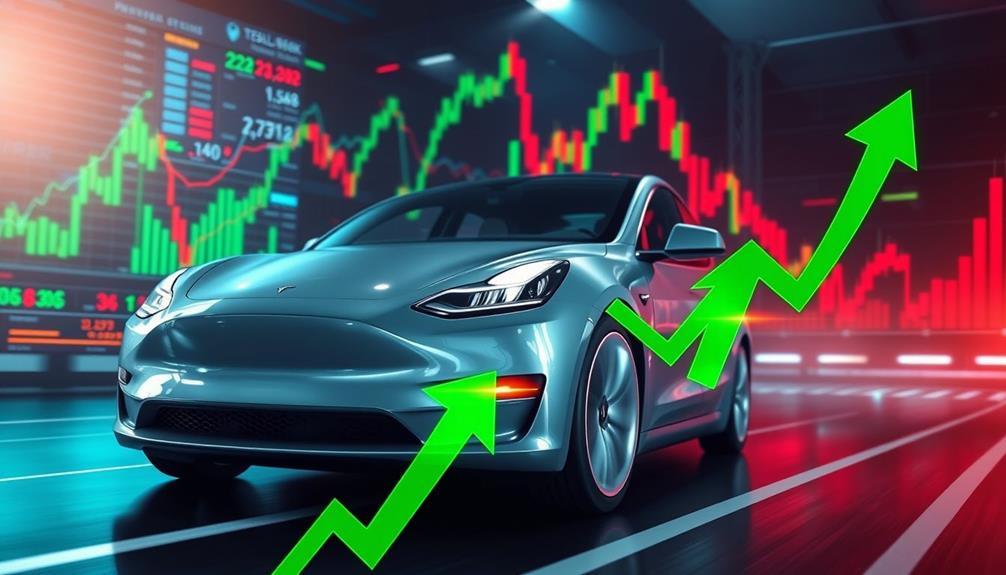
Tesla stock is currently a mixed bag, with recent declines raising concerns. It's down 12% year-to-date, and analysts predict a 28% drop in earnings per share for 2024. Yet, the upcoming Robotaxi reveal in October could change the game, as it's projected to weigh heavily on Tesla's future value. Some analysts, like those at Morgan Stanley, see a potential 40% upside despite the risks. You'll want to assess how Tesla's competitive position and regulatory challenges might impact your investment before making a decision, especially with exciting developments on the horizon.
Key Takeaways
- Tesla stock has declined 12% year-to-date and 20% since July 2024, signaling potential risks for investors.
- Upcoming Robotaxi reveal on October 10, 2024, is crucial for long-term growth and could influence stock price significantly.
- Analysts project a 28% decline in EPS for 2024, which raises concerns about Tesla's financial trajectory.
- Increased competition and regulatory challenges, including tariffs and recalls, may impact Tesla's market position and profitability.
- Positive analyst sentiment remains, with Morgan Stanley projecting a 40% upside, suggesting potential recovery for the stock.
Tesla Stock Performance Overview

Tesla's stock performance has been a rollercoaster ride lately, with shares down about 12% year-to-date and facing a 20% decline since hitting their July 2024 highs. The company recently reported its Q2 2024 earnings, which fell 43% to 52 cents per share. Despite the dip in earnings, Tesla remains a key player in the electric vehicle market, continuing to innovate with new models and expansions. Investors are closely watching for signs of recovery, but many wonder, “does Tesla pay dividends?” Currently, Tesla does not offer dividends, focusing instead on reinvesting profits to fuel further growth and innovation.
While that sounds alarming, revenue slightly increased to $25.5 billion, surpassing analysts' expectations despite the drop in earnings.
Looking ahead, analysts predict a significant decrease in earnings per share for 2024, estimating it at $2.24—down 28% from the previous year's $3.12. This projected decline raises questions about Tesla's growth potential and overall stock performance.
Despite these challenges, Tesla's stock has shown resilience, rebounding approximately 60% from late-April lows. However, it struggles to maintain support at the 50-day moving average, signaling potential volatility ahead.
Currently, Tesla ranks third in the IBD Auto Manufacturers industry group, holding a Composite Rating of 67, which reflects moderate investor sentiment compared to its peers. Given these factors, you'll want to keep a close eye on Tesla's stock as you decide whether it aligns with your investment strategy.
Recent Earnings Analysis

Tesla's Q2 earnings report shows a 43% drop in earnings per share, coming in below analyst expectations.
Despite a revenue increase, the declining gross margins suggest that maintaining profitability is becoming tougher.
Looking ahead, projections for 2024 indicate a further decline in earnings, raising questions about the company's financial trajectory.
Q2 Earnings Overview
In the wake of Q2 earnings, investors faced disappointment as earnings fell by 43% year-over-year to 52 cents per share, missing analysts' expectations of 61 cents.
Despite a slight revenue increase of 2% to $25.5 billion, the decline in earnings per share notably impacted investor sentiment. The company's gross margins also took a hit, decreasing by 23 basis points to 18%, with auto gross margins specifically at 15.1%.
This underperformance led to a negative reaction in the market, resulting in a 7.7% drop in Tesla's stock price in August.
The outlook for 2024 isn't looking much better, with projections estimating a further decline in earnings per share to $2.24, marking a 28% decrease from the 2023 figure of $3.12.
Additionally, Tesla currently ranks third in the IBD Auto Manufacturers industry group with a Composite Rating of 67, reflecting mixed market performance following the latest earnings report.
As you assess Tesla's stock, it's essential to weigh these factors and consider how they align with your investment strategy.
Future Earnings Projections
Following the disappointing Q2 earnings report, it's important to look ahead at future earnings projections for Tesla. Analysts project the company's earnings per share (EPS) will drop to $2.24 in 2024, which is a concerning 28% decline from 2023's EPS of $3.12. This decline highlights the ongoing challenges Tesla faces in maintaining profitability amidst increasing costs and competitive pressures.
Despite a slight revenue growth of 2% year-over-year, the reduction in gross margins to 18%—with auto gross margins at just 15.1%—indicates that profitability is under strain.
Investors reacted negatively to the recent earnings news, leading to a notable 7.7% drop in Tesla's stock price in August 2024.
To navigate these challenges, Tesla needs to focus on cost management and innovation to sustain its market position. If the company can effectively address these issues, future earnings projections could improve.
However, as it stands, investor sentiment remains cautious. It's essential for you, as an investor, to monitor how Tesla responds to these challenges moving forward before making any decisions on whether to buy or hold.
Robotaxi Developments and Expectations

Tesla's upcoming Robotaxi revelation on October 10, 2024, is generating buzz as investors evaluate its potential impact on the company's stock.
With projections estimating that the Robotaxi business could account for 90% of Tesla's enterprise value by 2029, you'll want to think about how this could shift your investment strategy.
However, keep an eye on market competition and the challenges that lie ahead as Tesla pushes forward with this ambitious initiative.
Upcoming Robotaxi Unveiling Date
Anticipation is building for the disclosure of Tesla's Robotaxi, now set for October 10, 2024, after a delay from its initial date of August 8. This extra time allows for design improvements, underscoring Tesla's commitment to delivering a superior product.
Elon Musk has pledged $10 billion in 2024 to enhance AI training and infrastructure, specifically aimed at optimizing the Robotaxi's ride-hailing capabilities.
Ark Invest has been vocal about the significance of the upcoming robotaxi disclosure date, projecting that Tesla's enterprise value will hinge on the success of this venture. If the Robotaxi initiative flourishes, Ark Invest estimates a price target of $2,600 per share by 2029.
However, they also warn that without a successful robotaxi network, this target could drop dramatically to $350 per share.
This stark contrast highlights the critical importance of the Robotaxi project for Tesla's future. As confidence builds in the launch of the robotaxi service within the next five years, many investors are maintaining a long-term bullish outlook on Tesla's autonomous driving initiatives, setting the stage for potential growth.
Financial Projections and Impact
The anticipated launch of Tesla's Robotaxi service is poised to markedly impact the company's financial projections and overall valuation.
With Elon Musk allocating $10 billion for AI training and improvements aimed at enhancing this service, it's clear that this initiative is vital for Tesla's future. The revelation has been postponed to October 10, 2024, reflecting the importance of getting the design right before launch.
Investors should note the following:
- Ark Invest predicts that by 2029, 90% of Tesla's enterprise value could hinge on the robotaxi business.
- If successful, the price target could soar to $2,600 per share; however, without the robotaxi network, estimates suggest a potential drop to $350.
- Confidence in launching the robotaxi service within five years signals a long-term bullish outlook for Tesla's autonomy efforts.
Market Competition and Challenges
As the robotaxi service draws closer to its launch date, the competitive landscape in the autonomous vehicle market becomes increasingly intense.
Tesla's revelation has been postponed to October 10, 2024, which demonstrates the company's commitment to refining its technology. This delay could impact Tesla's market competition, especially as rivals accelerate their advancements in self-driving capabilities.
Elon Musk's $10 billion investment in AI training and infrastructure aims to enhance the ride-hailing functionality of Tesla's robotaxi initiative.
If successful, Ark Invest predicts that by 2029, 90% of Tesla's enterprise value will tie to this robotaxi business, potentially elevating the stock price to $2,600 per share. However, without the robotaxi's success, estimates drop to just $350.
While confidence in launching the robotaxi service within five years suggests a bullish outlook on Tesla's autonomy initiatives, you should consider that delays could hinder its competitive edge.
Rivals like Uber and Lyft are also improving their self-driving technologies, intensifying the race for market dominance.
As an investor, it's essential to keep these factors in mind when evaluating Tesla's future potential.
Upcoming Vehicle Production Plans

Tesla's upcoming vehicle production plans are generating buzz among investors and consumers alike. As you keep an eye on the market, it's vital to note that the company is aiming to mass-produce a more affordable model, previously referred to as Model 2, by the first half of 2025.
However, there are whispers that this model might be scrapped altogether.
While Tesla anticipates vehicle volume growth for 2024, it's projected to be lower than in 2023, creating potential challenges in meeting market demand.
Significantly, Q3 2024 delivery estimates project 458,000 units, reflecting a modest 5% year-over-year growth despite the overall decline in vehicle volume growth.
To help you understand Tesla's direction, consider these key points:
- Upcoming production of upgraded Model Y and Cybertruck models is expected to boost consumer interest.
- The focus on diversifying production plans includes a rapidly growing energy storage business.
- Maintaining market competitiveness will require adapting to evolving consumer preferences.
These production plans could play an important role in Tesla's performance as you evaluate its stock potential.
Regulatory Challenges Impacting Tesla

In light of ongoing regulatory challenges, Tesla faces significant hurdles that could impact its market performance. The company is currently grappling with a 9% tariff on vehicles imported from China to the EU, coupled with a 10% tariff on all foreign-made cars. This affects its pricing strategy and competitiveness in the European market. Additionally, Tesla has been under scrutiny for over seven years regarding faulty suspension and steering parts, with investigations in Norway and Sweden specifically targeting the Model S and X vehicles.
Moreover, the NHTSA's recent over-the-air recall affecting over 2 million Tesla vehicles due to Autopilot misuse adds another layer of regulatory scrutiny over its self-driving technologies. These challenges create uncertainties that can erode investor confidence and inflate operational costs for Tesla moving forward.
| Regulatory Issue | Impact on Tesla |
|---|---|
| Tariffs on imported vehicles | Increased pricing pressures |
| Investigations on vehicle parts | Potential recalls and repairs |
| NHTSA recall of Autopilot | Higher scrutiny on safety |
As these regulatory challenges persist, you'll want to keep a close eye on how they affect Tesla's overall market strategy and performance.
Investor Sentiment and Market Dynamics
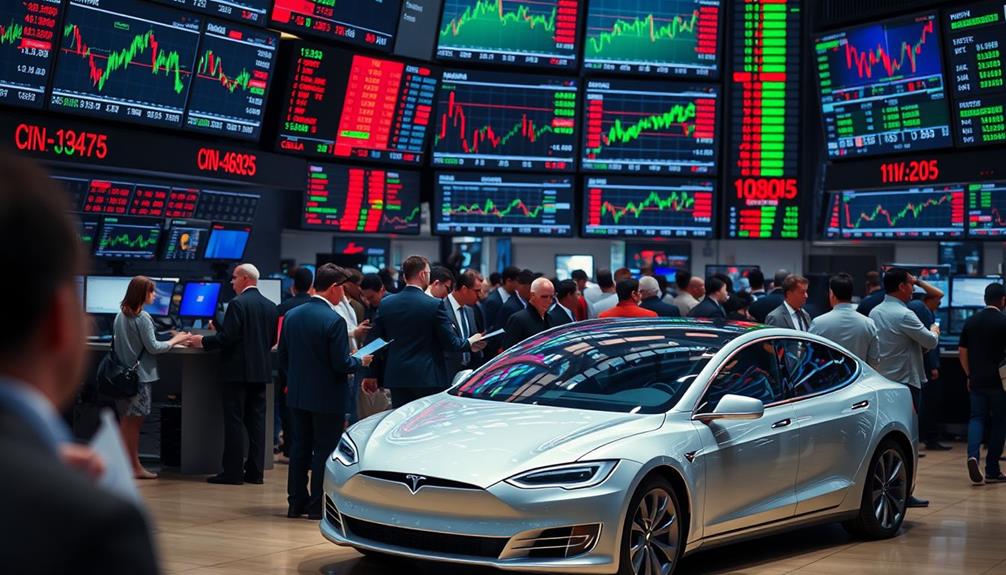
Investor sentiment around Tesla has been quite volatile lately, reflecting broader market dynamics and the company's recent performance. The stock has plummeted 12% year-to-date and 20% since its July 2024 highs, primarily due to disappointing Q2 earnings.
However, a recent rebound of about 20% over the past month shows that not all hope is lost.
As you navigate your investment decisions, consider these factors:
- Analysts anticipate a 28% decline in earnings per share for 2024, raising concerns.
- Morgan Stanley's bullish outlook identifies Tesla as a top pick, projecting a potential 40% upside.
- The upcoming Robotaxi revelation on October 10 could greatly sway investor sentiment and market dynamics.
Despite the challenges, advancements in self-driving technology and strong delivery estimates support a more positive outlook.
Q3 projections indicate a 5% year-over-year growth in deliveries, reaching 458,000 units. Ark Invest even set a TSLA price target of $2,600 by 2029, which could fuel optimism.
Analyst Recommendations and Insights

Analysts are closely watching Tesla as it navigates a challenging landscape, and their recommendations reflect a mix of caution and optimism.
Morgan Stanley recently named Tesla its top pick in the U.S. auto sector, projecting a considerable 40% upside for TSLA stock. This positive outlook comes despite analysts forecasting a decline in earnings per share for 2024, estimating it to be $2.24, down from $3.12 the previous year. This signals a cautious sentiment among experts.
Interestingly, Tesla's stock has rebounded about 20% over the past month after a 12% decline year-to-date, indicating potential recovery confidence among investors.
The IBD Auto Manufacturers industry group ranks Tesla third with a Composite Rating of 67, suggesting moderate strength compared to its peers.
Looking ahead, analysts emphasize the importance of the upcoming Robotaxi reveal on October 10. This event could considerably influence future stock performance and investor sentiment, making it a key date for those considering an investment in TSLA stock.
Corporate Governance and Leadership

When you look at Tesla's corporate governance, Elon Musk's influence stands out, especially after shareholders approved his $56 billion pay package.
His push for increased voting power shows his intent to steer the company's strategy, particularly in AI and robotics.
Balancing his control with shareholder interests is essential as Tesla navigates the competitive landscape of the tech-driven automotive sector.
Musk's Voting Power Influence
While Musk's substantial influence over Tesla's corporate governance is evident, his recent moves to enhance his voting power raise important questions about the balance between leadership authority and shareholder interests.
With nearly 13% of Tesla's shares, down from 22% before his Twitter acquisition, Musk seeks to increase his voting power to 25%. This shift would give him greater authority over vital decisions in AI and robotics.
Musk's ambition to solidify his control reflects broader market dynamics and poses potential risks and rewards.
Consider these implications:
- Strategic Control: Increased voting power could lead to more cohesive decision-making, aligning Tesla's direction with Musk's vision.
- Shareholder Concerns: His growing influence may raise alarms among shareholders about the concentration of power, potentially affecting their trust.
- Innovation vs. Risk: While his leadership is often a catalyst for innovation, excessive control might stifle diverse perspectives and challenge the company's adaptability.
Ultimately, understanding Musk's voting power influence is essential for evaluating Tesla's long-term prospects and determining whether it aligns with your investment strategy.
Shareholder Approval Dynamics
Steering the dynamics of shareholder approval is vital for understanding Tesla's corporate governance and leadership landscape. Recently, shareholders showed strong confidence in Elon Musk's leadership by approving his $56 billion pay package, indicating their belief in his vision for Tesla's future. This approval reflects a positive endorsement amidst Musk's efforts to enhance his control over the company, particularly as he seeks to increase his voting power to 25%.
Musk currently holds about 13% of Tesla's shares, down from 22% after his Twitter acquisition, which highlights a notable shift in his ownership stake. The recent approval for Tesla's reincorporation in Texas aligns with his strategy to operate in a more business-friendly environment.
However, the dynamics of shareholder approval also underscore the balance between Musk's control and the influence of other shareholders. While Musk's ambitions to steer Tesla's direction in AI and robotics are ambitious, the voice of the shareholders remains essential in corporate governance decisions.
As you consider investing in Tesla, keep an eye on how these dynamics evolve, as they can greatly impact the company's strategic path and, ultimately, its stock performance.
Corporate Strategy and Control
Understanding Tesla's corporate strategy and control is key to grasping its future direction. The company's governance reflects a delicate balance between Elon Musk's influence and shareholder interests. Recently, shareholders reaffirmed their confidence in Musk by approving his substantial pay package and the relocation to Texas. This move signals strong backing for his vision, despite Musk's efforts to regain greater voting control after his shareholding decline.
Key elements of Tesla's corporate governance strategy include:
- Balancing Control: Maintaining agility while addressing investor concerns about Musk's influence.
- Strategic Innovation: Focusing on risk management in artificial intelligence and robotics for long-term growth.
- Navigating Challenges: Proactively addressing regulatory and competitive landscapes in the evolving electric vehicle market.
Musk holds nearly 13% of Tesla's shares, and his quest to regain more influence underscores the ongoing dynamics between his leadership and shareholder governance.
As Tesla maneuvers through a rapidly changing industry, understanding this corporate strategy will help you evaluate the stock's potential and its alignment with your investment goals.
Competitive Landscape and Market Position
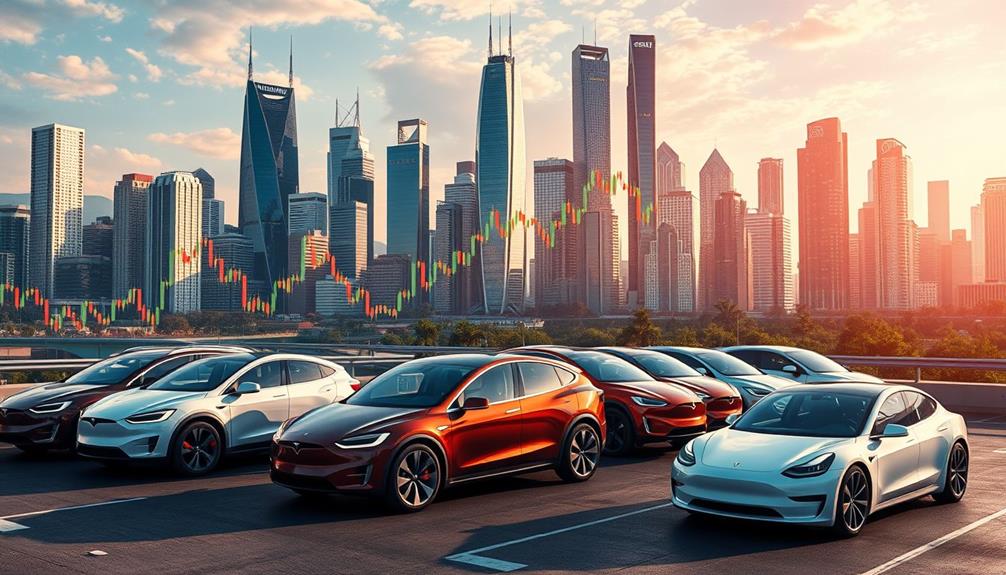
In today's dynamic electric vehicle market, Tesla's competitive landscape is becoming increasingly challenging. Despite ranking third in the IBD Auto Manufacturers industry group with a Composite Rating of 67, the company faces intensified competition from established automakers rapidly rolling out their electric models. This could threaten Tesla's market position and overall share.
Here's a brief look at some key factors affecting Tesla's competitive stance:
| Factor | Impact on Tesla | Notes |
|---|---|---|
| Analyst Confidence | Positive | Morgan Stanley projects a 40% upside for TSLA stock. |
| Import Tariffs | Moderate | EU's 9% tariff on Tesla vehicles from China is better than competitors. |
| Vehicle Volume Expectations | Negative | Expected growth is lower than previous years, signaling market challenges. |
While Morgan Stanley's optimistic Tesla stock price target reflects confidence, the hurdles from competition and tariffs may weigh heavily on the company's future. Investors should pay close attention to these dynamics as they navigate the evolving landscape.
Future Projections for Tesla Stock

Tesla's future projections paint a mixed picture for investors. While the long-term outlook for Tesla remains bullish, with expectations for growth driven by new model releases and advancements in full self-driving technology, there are also challenges on the horizon.
Analysts expect earnings per share to decline to $2.24 in 2024, a worrying 28% drop from 2023.
Key considerations for you include:
- Q3 2024 delivery estimates predict 458,000 units, indicating a slight slowdown in growth.
- Ark Invest's ambitious price target of $2,600 by 2029 hinges on the successful rollout of the robotaxi business, expected to contribute considerably to Tesla's enterprise value.
- The production of an affordable vehicle is slated for the first half of 2025, which could enhance Tesla's market share in the competitive EV segment.
As you evaluate the future projections for Tesla stock, weigh these factors carefully. Although the potential for recovery exists through innovative releases, short-term hurdles could impact your investment strategy.
Stay informed, as Tesla continues to shape the electric vehicle landscape.
Frequently Asked Questions
Is Tesla a Good Stock to Buy Right Now?
When considering Tesla, you should weigh its recent performance and volatility against future growth potential. Analyzing upcoming product launches and delivery estimates can help you decide if it aligns with your investment strategy.
What Is the Prediction for Tesla Stock?
Imagine steering through a vast ocean; Tesla's stock is the ship. Predictions suggest turbulent waters ahead, with earnings set to dip. Yet, the horizon shows promise, especially if new models and robotaxis sail smoothly into view.
What Is the Prediction for Tesla in 2024?
In 2024, you'll see Tesla facing earnings challenges with a projected 28% decline. However, vehicle volume growth and energy storage expansion might offer some upside, while the Robotaxi initiative could greatly impact long-term value.
Why Are Tesla Stocks Going Down?
You see Tesla stocks sliding due to disappointing earnings, shrinking margins, and looming regulatory challenges. As market confidence wanes, a projected EPS drop for 2024 adds to the uncertainty surrounding the company's financial future.
Conclusion
As you weigh whether Tesla stock is a buy right now, consider this: can you afford to miss out on the electric revolution? With promising earnings, innovative developments like robotaxis, and a solid market position, Tesla's future looks bright. However, keep an eye on regulatory hurdles and competition. Ultimately, the decision rests with you, but the potential for growth in this dynamic landscape is hard to ignore. Are you ready to take the leap?
Alex is our go-to expert on performance tuning, with over a decade of experience in the automotive industry. His deep understanding of engine dynamics, exhaust systems, and performance software allows him to break down complex concepts into easy-to-follow guides. Whether you’re looking to boost horsepower or fine-tune your vehicle’s responsiveness, Alex’s insights will help you achieve peak performance.
Tesla Tuning
Tesla’s New Truck Pricing: How Much Will You Pay?
Discover Tesla’s new Cybertruck pricing and what it means for your wallet, but the waitlist might surprise you!
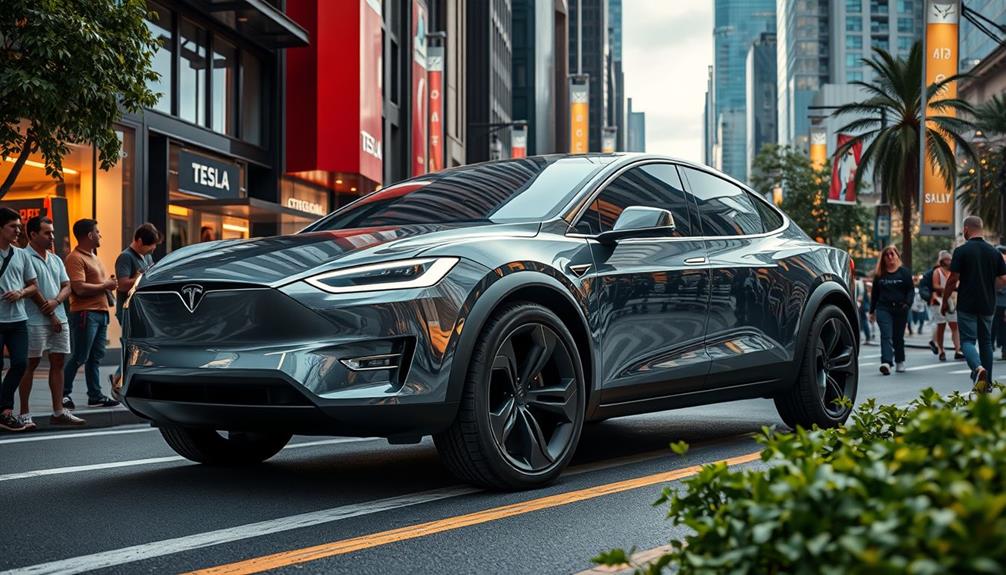
Tesla's new Cybertruck pricing starts at $60,990 for the rear-wheel drive model, while the dual-motor all-wheel drive version jumps to $79,990. If you're eyeing the powerful Cyberbeast, brace for a starting price of $99,990, going as high as $120,000 for some configurations. A $250 deposit secures your reservation, but keep in mind that demand has led to sold-out slots until 2027. You might also be eligible for federal tax credits, depending on your situation. To explore what other features and comparisons await, stick around for the details!
Key Takeaways
- The base price for the Tesla Cybertruck starts at $60,990 for the rear-wheel drive model.
- The dual-motor all-wheel drive variant is priced at $79,990.
- The tri-motor Cyberbeast model starts at $99,990, with some configurations reaching $120,000.
- Reservations require a $250 deposit and are sold out until 2027.
- Potential federal tax credits of up to $7,500 may apply, depending on eligibility.
Overview of Tesla Cybertruck Pricing

When it comes to pricing, the Tesla Cybertruck presents a striking array of options tailored to different budgets and needs. The starting price for the rear-wheel drive variant is set at $60,990, making it an appealing choice for those looking to enter the electric truck market.
If you prefer all-wheel drive, you'll find the dual-motor version priced at $79,990, while the tri-motor Cyberbeast variant starts at a hefty $99,990. Some configurations can push the purchase price up to around $120,000, depending on your preferences.
As of January 2024, new reservations have sold out until 2027, and you'll need to put down a $250 deposit to secure your spot.
It's worth noting that the base model was originally priced at $39,900 when reservations opened in November 2019, but increased demand and rising production costs have led to this surge in prices.
Keep an eye on the expected delivery event for the rear-wheel drive version, which is likely set for 2025, while production for other models has already begun.
This pricing landscape offers something for everyone, so you can choose what best fits your needs.
Cybertruck Foundation Series Details

The Tesla Cybertruck Foundation Series starts at around $100,000 and offers impressive features like a dual-motor, all-wheel drive layout and the Full Self-Driving suite.
You'll also appreciate the added versatility with hardware that allows power sharing for external accessories.
While the first version is available for purchase, you might want to keep an eye on the expected delivery timelines, which haven't been specified yet.
Pricing and Features Overview
Exploring the Tesla Cybertruck Foundation Series reveals a striking blend of advanced features and competitive pricing. Starting at approximately $100,000, this model positions itself as a formidable contender in the electric trucks market.
With a dual-motor, all-wheel drive layout, you'll experience impressive performance and handling in various conditions.
One of the standout features is the inclusion of the Full Self-Driving suite, which enhances your driving experience by automating several functions. Additionally, the Cybertruck is equipped with a light bar, ensuring better visibility during night-time adventures or off-road excursions.
You'll also appreciate the hardware designed for power sharing with external accessories, providing versatility for your lifestyle.
This first version of the Cybertruck Foundation Series is now available for purchase, reflecting Tesla's commitment to innovation and state-of-the-art technology in the electric truck sector.
With competitive pricing and a host of features designed to enhance both utility and enjoyment, the Tesla Cybertruck is poised to redefine what you expect from electric trucks.
It's an exciting time to contemplate this groundbreaking vehicle for your needs.
Expected Delivery Timeline
As excitement builds for the Tesla Cybertruck Foundation Series, many are curious about when they can expect their orders to arrive. While the Cybertruck, starting at a price around $100,000 for the dual-motor, all-wheel drive version, is officially available for purchase, Tesla hasn't specified an expected delivery timeline.
This lack of detailed delivery information can be frustrating, especially given the high demand for this innovative vehicle.
As of January 2024, new reservations for the Cybertruck have sold out until 2027, which highlights just how popular this model is. With the inclusion of the Full Self-Driving suite and hardware for power sharing with external accessories, it's no surprise that customers are enthusiastic to get their hands on it.
However, if you're considering placing an order, keep in mind that the wait might be longer than anticipated.
While you may have to be patient, rest assured that the Cybertruck Foundation Series aims to deliver cutting-edge technology and performance.
Just remember to stay updated on any announcements from Tesla regarding the expected delivery timeline, as they might provide more clarity in the coming months.
Rear-Wheel Drive Pricing and Specs
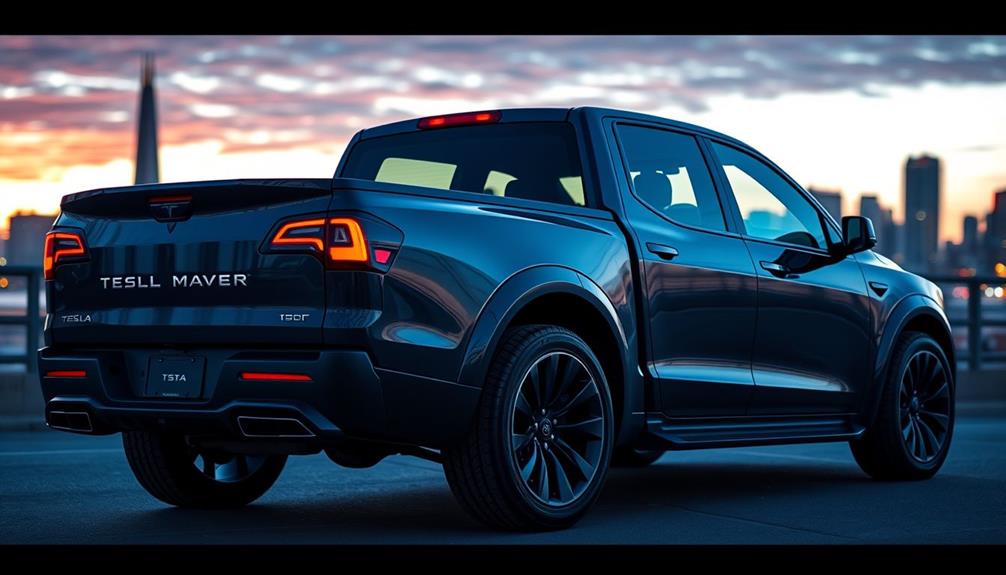
Tesla's Cybertruck Rear-Wheel Drive model combines innovative design with impressive specs, making it an exciting option for electric truck enthusiasts. Priced at $60,990, this rear-wheel drive version is set to hit the market in 2025, offering a compelling package for those seeking performance and utility.
Here's a quick look at some key features:
| Feature | Specification |
|---|---|
| Price | $60,990 |
| Estimated Range | 250 miles |
| Towing Capacity | 7,500 pounds |
| 0-60 mph Acceleration | 6.5 seconds |
| Top Speed | 112 mph |
| Curb Weight | 6,660 lbs |
With an estimated range of 250 miles on a single charge, you'll enjoy plenty of driving capability. The acceleration from 0 to 60 mph in just 6.5 seconds is impressive for a truck of this size. Plus, the 7,500 pounds towing capacity guarantees you can handle tough jobs with ease. The Cybertruck's cold-rolled stainless steel body not only enhances durability but also adds to its unique aesthetic appeal.
All-Wheel Drive Model Details
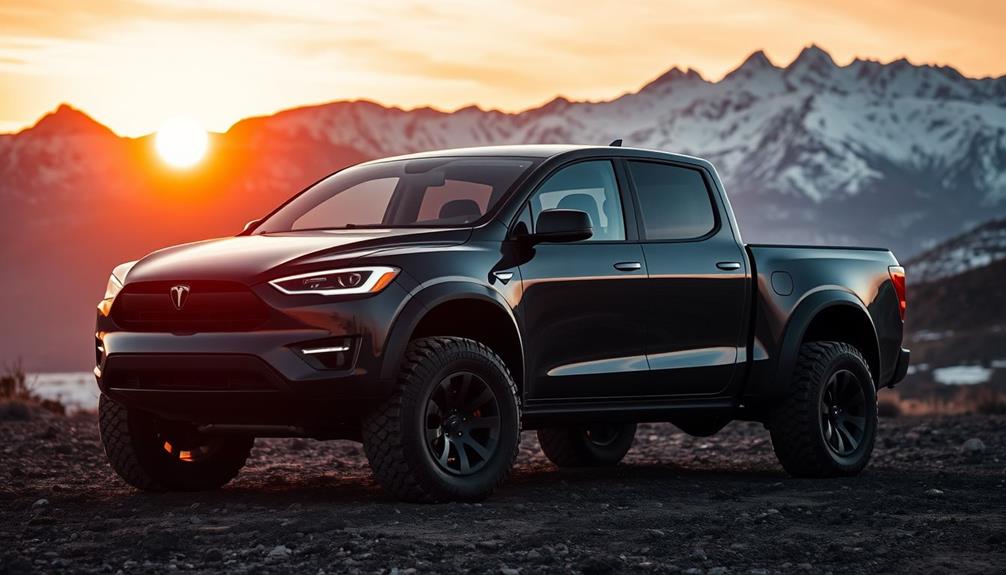
The Cybertruck All-Wheel Drive (AWD) model stands out with its robust performance and impressive specifications, making it an attractive choice for those in need of a versatile electric truck. Priced at $79,990, this model offers an estimated range of 340 miles on a single charge, so you can tackle long journeys with confidence.
With a remarkable acceleration time of just 4.1 seconds from 0 to 60 mph, the AWD model proves it can hold its own against traditional trucks. Its top speed reaches 112 mph, ensuring you're always ready for any challenge on the road.
One of the standout features is its towing capacity of 11,000 pounds, making it perfect for heavy-duty tasks like hauling trailers or equipment.
Additionally, the AWD model includes advanced adaptive air suspension, giving you 12 inches of travel and 17 inches of ground clearance. This feature enhances its off-road capabilities, allowing you to navigate rough terrains with ease.
Whether you're commuting or exploring, the Cybertruck AWD is designed to meet your needs while delivering outstanding performance and versatility.
Cyberbeast Pricing and Features
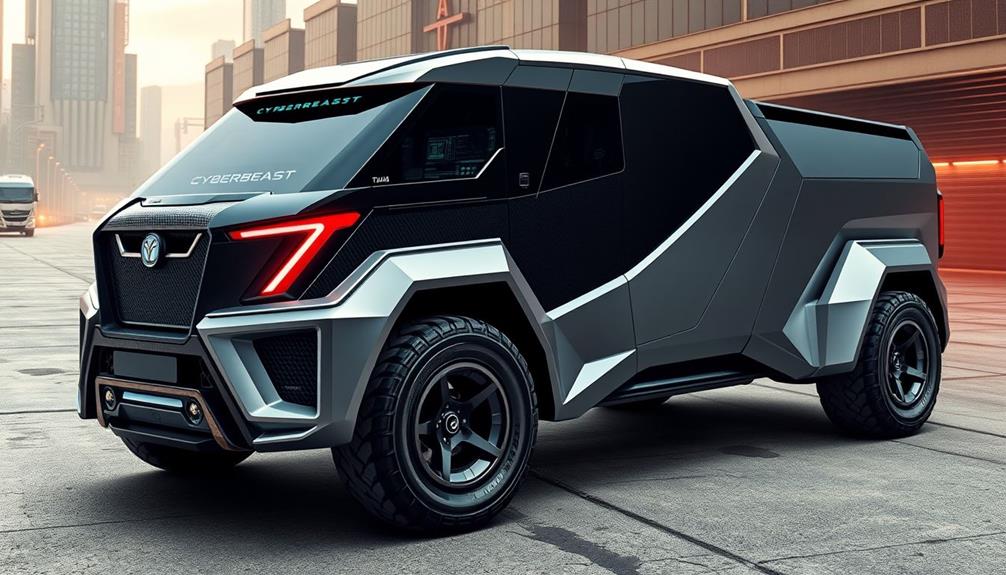
Introducing the Cyberbeast, a powerhouse of innovation and performance in the electric truck market. Starting at an estimated price of $99,990, this beast of a vehicle offers configurations that can reach around $120,000, depending on the features you choose.
With a staggering output of 845 horsepower, you'll enjoy an exhilarating acceleration from 0 to 60 mph in just 2.6 seconds, making it one of the fastest trucks available.
When it comes to range, the Cyberbeast impresses with a claimed distance of 320 miles on a single charge. If you need more mileage, you can opt for the range extender option, which boosts the range up to 440 miles.
Plus, with a towing capacity of 11,000 pounds, this truck is designed for heavy-duty tasks, ensuring you can tackle any challenge.
The Cyberbeast also includes advanced features like the Full Self-Driving suite and hardware for power sharing with external accessories.
These features enhance your driving experience while providing unmatched utility. When considering the Cyberbeast, you're not just investing in a truck; you're stepping into the future of electric vehicles.
Optional Features and Costs

When considering your Tesla Cybertruck, you'll want to think about the optional features that can enhance your experience.
For instance, the range extender can add significant driving distance for $16,000, while interior upgrades and accessories can also increase your overall costs.
Understanding these options will help you make the best choice for your needs and budget.
Range Extender Pricing
For those planning long trips or needing to tow heavy loads, adding the range extender option to your Tesla Cybertruck might be a smart choice. Priced at an estimated $16,000, this option provides an additional 120-130 miles of range, greatly enhancing your Cybertruck's capabilities. With a 50kWh battery seamlessly integrated into the existing powertrain, the range extender not only boosts your miles of range but also makes your vehicle more versatile for various driving needs.
Here's a quick overview of what the range extender offers:
| Feature | Details | Benefits |
|---|---|---|
| Price | $16,000 | Affordable upgrade for long trips |
| Additional Range | 120-130 miles | Ideal for extensive driving |
| Total Maximum Range | Up to 470 miles (varies by model) | Perfect for towing heavy loads uphill |
| Battery Capacity | 50kWh | Enhances overall power and efficiency |
Investing in the range extender can be particularly valuable for those who frequently travel long distances or require extra power for towing. Consider how this option can elevate your Cybertruck experience.
Interior Upgrade Options
Enhancing your Tesla Cybertruck's interior with various upgrade options can greatly elevate your driving experience. The Cybertruck comes standard with an impressive 18.5-inch front touchscreen and a 9.4-inch second-row touchscreen for rear passengers, ensuring a modern and functional environment for everyone aboard.
With passenger accommodation for up to five people, you can enjoy both comfort and technology on the road.
For those who love the outdoors, consider the optional Basecamp tent, priced around $3,000. This addition expands the utility of your Cybertruck, allowing you to transform it into a mobile campsite.
If you're keen on customization, you might also look into a light bar upgrade that illuminates up to 525 yards ahead, enhancing visibility during nighttime driving.
Further customization options include body wraps and spare wheel setups, which allow you to personalize your vehicle's aesthetic and functionality.
Each of these interior upgrade options contributes to making your Cybertruck not just a vehicle, but a tailored experience that fits your lifestyle and needs.
Optional Accessories Costs
With your Tesla Cybertruck, you can tailor your vehicle to suit your lifestyle through a variety of optional accessories.
These features enhance both functionality and style, making it perfect for your needs. Here are some key options you might consider:
- Range Extender: For $16,000, you can add an extra 120-130 miles to your drive model, ensuring you'll have ample range for long trips.
- Basecamp Tent: Priced at around $3,000, this tent is designed for outdoor use, perfect for camping enthusiasts looking to explore.
- Light Bar Upgrade: This optional feature enhances nighttime visibility, illuminating up to 525 yards ahead, ensuring safe travels after dark.
- Body Wraps: Customize your Cybertruck's exterior with body wraps, allowing you to express your personal style, although specific pricing details vary.
Additionally, consider adding a spare wheel setup for extra utility, especially if you enjoy off-roading or need more storage area for heavy loads.
These optional features not only elevate your Cybertruck but also enhance your adventures on the road.
Comparison With Competitors

The Tesla Cybertruck's pricing stands out in the electric truck market, particularly when compared to its competitors. Starting at $80,240, the Cybertruck positions itself above the Ford F-150 Lightning, which begins around $50,000, and the Chevrolet Silverado EV at about $52,000.
If you look at the Rivian R1T, it starts at approximately $73,000, making it a bit closer but still less expensive than the Cybertruck.
The GMC Hummer EV Pickup is a notable outlier, priced near $110,000, making it one of the most expensive options on the market.
Tesla also offers varying configurations for the Cybertruck, with the dual-motor AWD variant starting at $79,990 and the tri-motor variant (Cyberbeast) beginning at $99,990, highlighting its premium pricing strategy.
However, you might find some relief in potential savings. Buyers of the Cybertruck could be eligible for a federal tax credit of up to $7,500, which might help bridge the gap in pricing when compared to its competitors.
It's crucial to weigh these factors when considering your options in the electric truck market.
Federal Tax Credit Eligibility

Maneuvering through the federal tax credit landscape can substantially impact your decision to purchase a Tesla Cybertruck.
Understanding eligibility is vital for maximizing your savings. Here are some key points to keep in mind:
- Federal Tax Credit Amount: You could qualify for up to $7,500 if you meet specific criteria.
- Vehicle Price Caps: To snag the full credit, the Cybertruck's MSRP mustn't surpass $80,000, which applies to the base model.
- Income Requirements: The eligibility hinges on your adjusted gross income, with limits in place to focus benefits on middle-income buyers.
- State-Specific Incentives: Don't forget to check your local regulations, as additional credits may also be available.
Anticipated Delivery Timelines
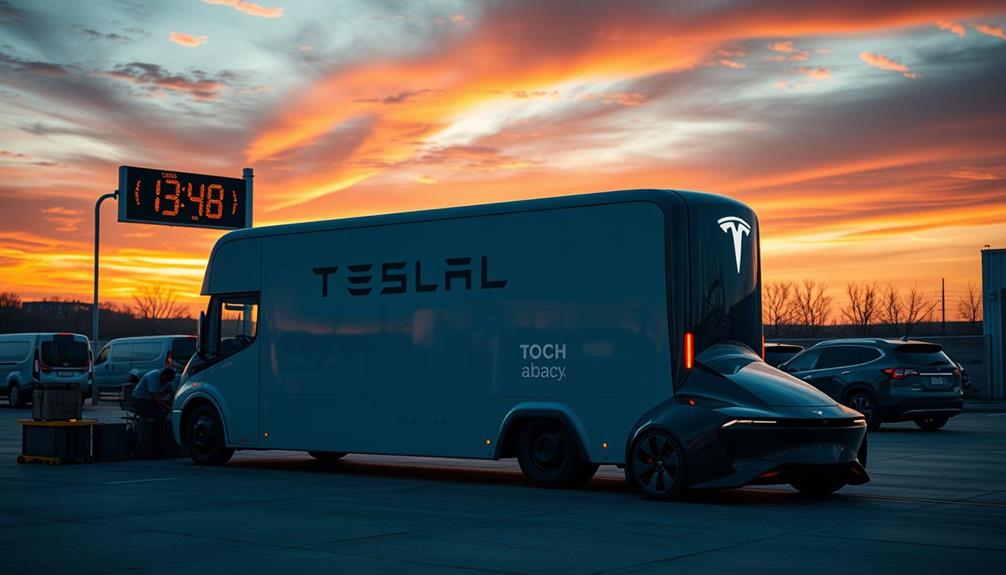
As you look forward to getting your Tesla Cybertruck, it's essential to know the anticipated delivery timelines. The Cybertruck has finally entered production, with initial deliveries starting in late November 2023.
If you've reserved a dual-motor all-wheel drive or tri-motor variant, you can expect these models to be available in 2024. The rear-wheel drive version, however, won't be ready until 2025.
Demand for the Cybertruck is sky-high, as evidenced by new reservations being sold out until 2027 as of January 2024. This reflects a strong market interest in Tesla's innovative truck.
Tesla aims to ramp up production considerably, targeting 250,000 units annually by 2025, which should help reduce wait times for future orders.
If you're among the lucky few who secured an early reservation, you can anticipate taking delivery of your Cybertruck soon.
For those who missed out, patience is key, as the Cybertruck will be available in increasing numbers in the coming years.
Stay tuned for updates on your order status and enjoy the excitement of owning one of the most anticipated vehicles on the market!
Frequently Asked Questions
How Much Will the Tesla Truck Actually Cost?
You'll find the Tesla truck's cost varies based on the model. Starting prices range from around $60,990 for the base version to about $99,990 for the high-performance variant, with configurations potentially exceeding $120,000. Additionally, factors like custom features, battery range, and autopilot capabilities can significantly impact the final price. As new Tesla model prices evolve, it’s expected that advanced technologies or limited edition releases may further increase the cost. Tax incentives and rebates, however, may help offset some of these expenses depending on location.
How Much Is a 2024 Tesla Pickup?
A 2024 Tesla pickup starts around $60,990 for the rear-wheel drive model, with all-wheel drive options priced higher. Depending on the features you choose, costs can easily exceed $100,000 for premium configurations.
How Much Is a Downpayment on a Tesla Cybertruck?
The downpayment for a Tesla Cybertruck's currently set at $250. It increased from the original $100 deposit. If you're interested, you might want to secure your reservation soon, as demand's skyrocketing.
What Is Monthly Payment for Cybertruck?
Your monthly payment for a Cybertruck varies by model and financing terms. For instance, a dual-motor AWD could cost around $1,150, while the Cyberbeast might reach approximately $1,850. Don't forget additional expenses!
Conclusion
In the end, deciding on your Tesla Cybertruck is like picking your favorite superhero—there's just so much to love! With jaw-dropping specs and options that'll make your head spin, you're bound to feel like a kid in a candy store. Just imagine cruising in a truck that turns heads while saving the planet! And with potential tax credits, it's almost like Tesla's giving you a high-five for going electric. So, are you ready to join the Cybertruck revolution?
Alex is our go-to expert on performance tuning, with over a decade of experience in the automotive industry. His deep understanding of engine dynamics, exhaust systems, and performance software allows him to break down complex concepts into easy-to-follow guides. Whether you’re looking to boost horsepower or fine-tune your vehicle’s responsiveness, Alex’s insights will help you achieve peak performance.
-

 Hybrid Tuning2 months ago
Hybrid Tuning2 months agoPorsche Cayenne E-Hybrid Tuning: Unleashing the Beast Within the Luxury SUV
-
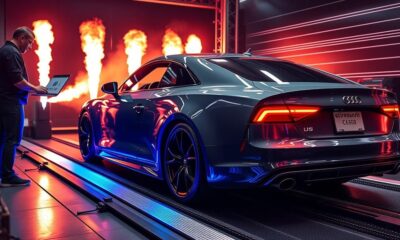
 Audi Tuning2 months ago
Audi Tuning2 months agoChip Tuning Audi: How to Unlock Extra Power Instantly
-

 Hybrid Tuning2 months ago
Hybrid Tuning2 months agoHonda Civic Hybrid Tuning: Unlocking Maximum Efficiency and Performance
-

 Automotive DIY and Professional Guides2 months ago
Automotive DIY and Professional Guides2 months agoWhen Is Car Tuning Required? Signs It’s Time for an Upgrade
-
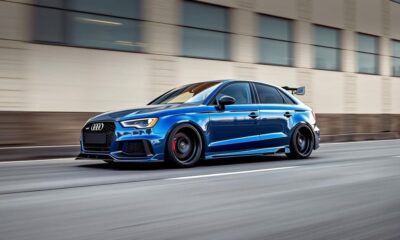
 Audi Tuning2 months ago
Audi Tuning2 months agoAudi A3 Tuning: Elevate Your Compact Car’s Performance
-
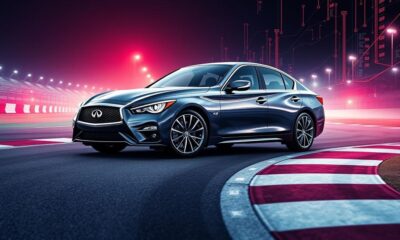
 Hybrid Tuning2 months ago
Hybrid Tuning2 months agoInfiniti Q50 Hybrid Chip Tuning: Enhance Performance With Precision Tuning
-

 Hybrid Tuning2 months ago
Hybrid Tuning2 months agoNissan Altima Hybrid Tuning: Upgrade Your Sedan for Maximum Efficiency
-

 Hybrid Tuning2 months ago
Hybrid Tuning2 months agoCube Reaction Hybrid Tuning: Get the Most Out of Your Electric Bike











